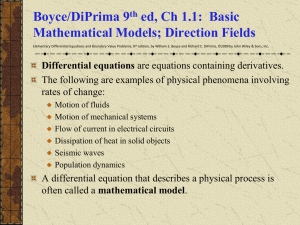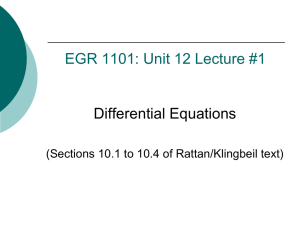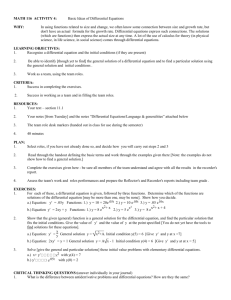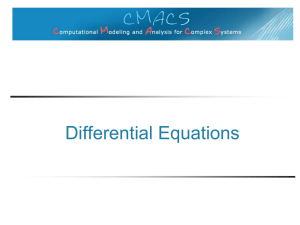Solution of Some DEs
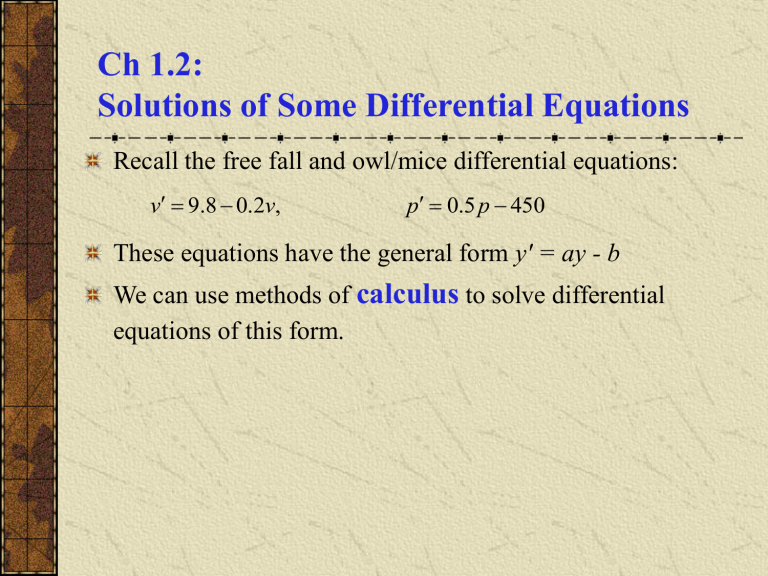
Ch 1.2:
Solutions of Some Differential Equations
Recall the free fall and owl/mice differential equations: v
9 .
8
0 .
2 v , p
0 .
5 p
450
These equations have the general form y' = ay - b
We can use methods of calculus to solve differential equations of this form.
Example 1: Mice and Owls
(1 of 3)
To solve the differential equation p
0 .
5 p
450 we use methods of calculus, as follows ( note what happens when p = 900
).
dp dt
0 .
5
p
900
ln p
900
0 .
5 t
C dp / dt p
900
0 .
5
p
900
p dp
900
0 .
5 dt
e
0 .
5 t
C
p
900
e
0 .
5 t e
C p
900
ke
0 .
5 t
, k
e
C
Thus the solution is p
900
ke
0 .
5 t where k is a constant.
Example 1: Integral Curves
(2 of 3)
Thus we have infinitely many solutions to our equation, p
0 .
5 p
450
p
900
ke
0 .
5 t
, since k is an arbitrary constant.
Graphs of solutions ( integral curves ) for several values of k , and direction field for differential equation, are given below.
Choosing k = 0, we obtain the equilibrium solution, while for k
0, the solutions diverge from equilibrium solution.
Example 1: Initial Conditions
(3 of 3)
A differential equation often has infinitely many solutions. If a point on the solution curve is known, such as an initial condition, then this determines a unique solution.
In the mice/owl differential equation, suppose we know that the mice population starts out at 850. Then p (0) = 850, and p ( t )
900
ke
0 .
5 t p ( 0 )
850
900
ke
0
50
k
Solution : p ( t )
900
50 e
0 .
5 t
Solution to General Equation
To solve the general equation (a ≠0) y
ay
b we use methods of calculus, as follows (y ≠b/a).
dy dt
a
ln b a
y
b / a
a t
dy / dt y
b / a
a
C
y dy
b / a y
b / a
e at
C
a dt
y
b / a
e at e C y
b / a
ke at , k
e C
Thus the general solution is where k y
b a
ke at , is a constant (k = 0 -> equilibrium solution).
Special case a = 0: the general solution is y = -bt + c
Initial Value Problem
Next, we solve the initial value problem (a ≠0) y
ay
b , y ( 0 )
y
0
From previous slide, the solution to differential equation is y
b a
ke at
Using the initial condition to solve for k , we obtain y ( 0 )
y
0
b a
ke
0 k
y
0
b a and hence the solution to the initial value problem is y
b a
0 b a
e at
Equilibrium Solution
Recall: To find equilibrium solution, set y' = 0 & solve for y : y
ay
b set
0
y ( t )
b a
From previous slide, our solution to initial value problem is: y
b a
0 b a
e at
Note the following solution behavior:
If y
0
= b / a, then y is constant, with y ( t ) = b/a
If y
0
> b / a and a > 0 , then y increases exponentially without bound
If y
0
> b / a and a < 0 , then y decays exponentially to b / a
If y
0
< b / a and a > 0 , then y decreases exponentially without bound
If y
0
< b / a and a < 0 , then y increases asymptotically to b / a

